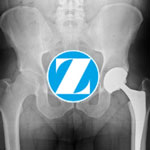A Doctor’s Concerns About A High Failure Rate In Zimmer Durom Cup Expected To Be Used In Lawsuits
 The Zimmer Durom Cup was approved by the FDA in 2006. Since then, the estimates are that the device has been implanted in about 13,000 patients in the United States. A temporary suspension of sales was announced by Zimmer in July 2008, but the product was re-released to the market around a month later, claiming that there was no evidence that the device was defective.
The Zimmer Durom Cup was approved by the FDA in 2006. Since then, the estimates are that the device has been implanted in about 13,000 patients in the United States. A temporary suspension of sales was announced by Zimmer in July 2008, but the product was re-released to the market around a month later, claiming that there was no evidence that the device was defective.
Those who have been injured after receiving the implant may be eligible to pursue a Zimmer hip lawsuit.
The Durom Cup was advertised as an innovative medical device meant to be used in younger patients when it was first placed on the market. The metal-on-metal design was intended to provide longer-lasting durability to reduce the need for multiple hip replacements in patients who needed surgery earlier in life. The metal component of the device, instead of being cemented to the bone, was treated with a material meant to discourage body ingrowth into the implant.
Some patients reported that the components were coming loose, resulting in severe pain and ultimate device failure.
Durom Cup has a significantly higher failure rate than Zimmer Trilogy
In September 2010, a study from the University of Wisconsin Clinical Science Center found a significantly higher rate of failure for the Durom Cup when compared to the Zimmer Trilogy hip implant. The cups failed because of a lack of bony ingrowth into the back of the cup.
In 2010, the U.S. Judicial Panel on Multidistrict Litigation consolidated each federal lawsuit against Zimmer hip into one court in New Jersey. The first bellwether trial is expected to begin in late 2012.
Former Zimmer consultant Dr. Lawrence Dorr alerts the manufacturer of failure rates
Reports of problems began in 2007 when prominent orthopedic surgeon and former Zimmer consultant Dr. Lawrence Dorr alerted the manufacturer to the abnormally high failure rates associated with it.
Dr. Dorr, the director of the Dorr Institute for Arthritis Research and Education and 30-year veteran of hip implant surgeries, alerted the company to implant problems from Zimmer hip in 2007. When the company failed to respond, Dr. Dorr wrote a letter to the American Association of Hip and Knee Surgeons in April 2008, noting apparent issues with the design of the Zimmer Durom Cup.
An Zimmer hip lawyer is likely to quote Dr. Dorr’s letter when presenting the facts in a lawsuit. For example, the doctor wrote, “We do not believe the fixation surface is good on these cups. We stopped using the cup after the first revisions.”
The doctor added that he had notified the company, but they had not responded, “We have notified Zimmer…The company does not believe it should pull the cup from the market so I am notifying all of my colleagues of our failure rate with this cup.”
Zimmer investigates the issues and blames surgeon error
In May of 2008, the company announced it would investigate the issues. On July 24, 2008, the company suspended distribution of the implant, but decided against implanting a recall of the device. Rather than institute a recall, Zimmer announced that their investigation had revealed that surgeon error was to blame for the reported hip problems. They updated the label and started a new surgical-training program in the U.S.
[SmartLink zimmerhiplawsuit]

